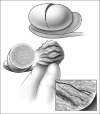Innovations in surgical management of nonobstructive azoospermia
- PMID: 26941489
- PMCID: PMC4756544
- DOI: 10.4103/0970-1591.173103
Innovations in surgical management of nonobstructive azoospermia
Abstract
Testicular sperm extraction (TESE) technique and intra-cytoplasmic sperm injection are breakthrough fertility treatments for men with nonobstructive azoospermia (NOA). Newer advances such as the microdissection-TESE (micro-TESE) technique have continued to build upon past success by improving sperm retrieval and minimizing the postoperative complications compared to TESE. However, even with micro-TESE, sperm retrieval success has ranged from 40% to 60% due to the technique's dependence on surgeon and embryologist experience. While postoperative complications are minimal relative to the traditional TESE technique, testicular tissue must still be extracted without the knowledge of whether sperm are present in biopsies. In this review, we discuss the innovations in the surgical management of men with NOA and describe the novel experimental approaches that can improve sperm retrieval success.
Keywords: Micro-testicular sperm extraction; nonobstructive azoospermia; testicular sperm extraction; testicular sperm extraction technique.
Figures




Similar articles
-
Microdissection testicular sperm extraction (micro-TESE) in men with infertility due to nonobstructive azoospermia: summary of current literature.Int Urol Nephrol. 2021 Nov;53(11):2193-2210. doi: 10.1007/s11255-021-02979-4. Epub 2021 Aug 19. Int Urol Nephrol. 2021. PMID: 34410586 Review.
-
Is a contralateral testicular exploration required at microdissection testicular sperm extraction for men with nonobstructive azoospermia, cryptozoospermia or severe oligozoospermia?Andrologia. 2021 Dec;53(11):e14208. doi: 10.1111/and.14208. Epub 2021 Aug 5. Andrologia. 2021. PMID: 34352113
-
Microdissection testicular sperm extraction (micro-TESE) as a sperm acquisition method for men with nonobstructive azoospermia seeking fertility: operative and laboratory aspects.Int Braz J Urol. 2013 May-Jun;39(3):440; discussion 441. doi: 10.1590/S1677-5538.IBJU.2013.03.21. Int Braz J Urol. 2013. PMID: 23849579
-
Testicular histopathology as a predictor of a positive sperm retrieval in men with non-obstructive azoospermia.BJU Int. 2013 Mar;111(3):492-9. doi: 10.1111/j.1464-410X.2012.11203.x. Epub 2012 May 15. BJU Int. 2013. PMID: 22583840
-
Microdissection testicular sperm extraction for men with nonobstructive azoospermia who have a testicular tumor in situ at the time of sperm retrieval.Asian J Androl. 2025 May 1;27(3):423-427. doi: 10.4103/aja2024109. Epub 2025 Feb 28. Asian J Androl. 2025. PMID: 40019188 Free PMC article. Review.
Cited by
-
Failed sperm retrieval from severely oligospermic or non-obstructive azoospermic patients on oocyte retrieval day: Emergent oocyte cryopreservation is a feasible strategy.PLoS One. 2019 Nov 18;14(11):e0224919. doi: 10.1371/journal.pone.0224919. eCollection 2019. PLoS One. 2019. PMID: 31738801 Free PMC article.
References
-
- Schoysman R, Vanderzwalmen P, Nijs M, Segal L, Segal-Bertin G, Geerts L, et al. Pregnancy after fertilisation with human testicular spermatozoa. Lancet. 1993;342:1237. - PubMed
-
- Schlegel PN. Testicular sperm extraction: Microdissection improves sperm yield with minimal tissue excision. Hum Reprod. 1999;14:131–5. - PubMed
-
- Ramasamy R, Yagan N, Schlegel PN. Structural and functional changes to the testis after conventional versus microdissection testicular sperm extraction. Urology. 2005;65:1190–4. - PubMed
-
- Andersson AM, Jørgensen N, Frydelund-Larsen L, Rajpert-De Meyts E, Skakkebaek NE. Impaired Leydig cell function in infertile men: A study of 357 idiopathic infertile men and 318 proven fertile controls. J Clin Endocrinol Metab. 2004;89:3161–7. - PubMed
Publication types
LinkOut - more resources
Full Text Sources
Other Literature Sources
Miscellaneous

